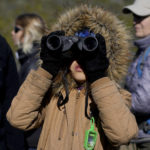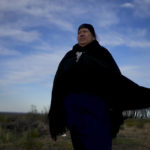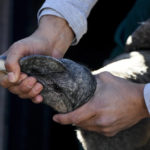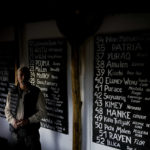Patagonia condor repopulation drive faces wind farm threat
Oct 18, 2022, 3:50 PM | Updated: 11:57 pm

An Andean condor named Yastay, meaning "God that is protector of the birds," in the Quechua Indigenous language, spreads his wings after being freed by the Andean Condor conservation program where he was born almost three years prior in Sierra Paileman in the Rio Negro province of Argentina, Friday, Oct. 14, 2022. For 30 years the Andean Condor Conservation Program has hatched chicks in captivity, rehabilitated others and freed them across South America. (AP Photo/Natacha Pisarenko)
(AP Photo/Natacha Pisarenko)
SIERRA PAILEMAN, Argentina (AP) — It was a sunny morning when about 200 people trudged up a hill in Argentina’s southern Patagonia region with a singular mission: free two Andean condors that had been born in captivity.
The emotion in the air was palpable as conservationists got ready for a moment that so many had been working toward for months. But the joyous moment was also bittersweet.
Preliminary plans for a massive wind farm that could be located in the Somuncura Plateau to feed a green hydrogen project is putting at risk a three-decade-long effort to repopulate Patagonia’s Atlantic coast with a bird that is classified as vulnerable to extinction by the International Union for the Conservation of Nature.
While members of the Mapuche, the largest Indigenous group in the area, played traditional instruments, and children threw condor feathers into the air that symbolized their good wishes for the newly liberated birds, an eerie silence engulfed the mountain in Sierra Paileman in Rio Negro province as researchers opened the cages where the two specimens of the world’s largest flying bird were kept.
Huasi (meaning home in Quechua) seemed born for this moment. As soon as the cage opened, he spread his wings and took off without a moment’s hesitation. Yastay (meaning god that is protector of birds) appeared cautious, uncertain of the wide open Patagonia skies after spending his first two years in captivity, and it took him around an hour before taking off.
People hugged while researchers sprang into action and started tracking the birds. In the back of their minds were latent worries about what the potential for new wind farms in the area could mean for the lives of these newly released birds.
Conservationists fear the birds inevitably would collide with the rotating blades of the turbines and be killed. In neighboring Chile, an environmental impact study for a planned wind farm with 65 windmills concluded that as many as four of the rare condors could collide with the massive structures yearly. Environmental authorities rejected the project last year.
“Why are we freeing two? We generally free more than two,” Vanesa Astore, executive director of the Andean Condor Conservation Program, said. “We’re at like a maintenance level now.”
Researchers had to release Huasi and Yastay now or risk that they would have to remain in captivity for the rest of their lives, which can range from 70 to 80 years, Astore explained, noting condors can only adapt to the outside world if they are released before their third birthday.
The current uncertainty regarding the future of the wind farm that would be built by Australian firm Fortescue Future Industries has not only put conservationists on alert but has prompted them to slow the pace of reproduction and release of the Andean condors even as the company insists it has no plans to set up shop in the Somuncura Plateau.
Condors are notoriously slow breeders that only reach sexual maturity at 9 years old and have an offspring every three years, but researchers have found ways to speed that up by removing eggs from pairs in captivity to incubate artificially. When the egg is removed, the pair will then produce another egg within a month, which they will raise while the first one is raised by humans with the help of latex puppets meant to simulate their parents and help them recognize members of their own species.
That strategy allow researchers to “increase reproductive capacity by six times,” said Luis Jacome, the head of the Andean Condor Conservation Program.
That effort is now on pause.
“We aren’t maximizing because I don’t know what’s going to happen,” Astore explained.
Since the conservation program started 30 years ago, 81 chicks have been born in captivity, 370 condors have been rehabilitated and 230 freed across South America, including Venezuela, Colombia, Ecuador, Chile and Bolivia.
Sixty-six of those have been released along Patagonia’s Atlantic coast, where the bird was nowhere to be seen at the turn of the century even though Charles Darwin had written in the early 1800s about the presence of the large birds in the region.
The Andean condor has now made a comeback, and for many locals that has a spiritual resonance.
“The condor flies very high, so our elders used to say that the condor could take a message to those who are no longer here,” said Doris Canumil, 59, a Mapuche who took part in the ceremonies for the liberation of the condors.
While they celebrate the success of the program, conservationists worry it could all be erased.
“These birds that we’ve liberated, that once again joined the mountain range with the sea through their flight, that have matured and had their own offspring that live and fly here in this place, they will simply die in the blades of the windmills,” Jacome said. “So the condor would once again become extinct in the Atlantic coast.”
Conservationists found out about the proposed wind farm through the media and alarm bells immediately went off.
Last year, Fortescue unveiled a plan to invest $8.4 billion over a decade in a project to produce green hydrogen for export in what the government touted as the largest international investment in Argentina over the past two decades. In order to qualify as green, the hydrogen must be produced using renewable power, and that is where the windmill farm would come in, taking advantage of the strong, reliable winds of Patagonia.
The government of President Alberto Fernández celebrated the project, saying it would create 15,000 direct jobs and somewhere between 40,000 and 50,000 indirect jobs.
Yet neither the company nor the provincial government of Rio Negro had carried out an environmental impact study before unveiling the project.
For now at least, Jacome said, the “only thing green are the dollars” attached to the project.
“We’re putting the cart before the horse,” Jacome said. “We need to have environmental impact studies that demonstrate what is going to be done, how many windmills, where they will be placed.”
Fortescue agrees and says it “is committed to evaluating the social, environmental, engineering, and economic considerations before committing to the development” of any project.
The Australian firm said in a statement that any pre-development study will include consultations with local organizations to “guarantee the protection of the local species such as the Andean Condor.”
Following questions about the project, Fortescue has decided to not measure winds at the Somuncura Plateau until the province finishes its environmental plan and will instead explore “other areas of interest within lands near Sierra Grande and the Province of Chubut,” the company said.
On Oct. 11, the Rio Negro provincial government said Fortescue launched a 12-month effort to analyze the environmental and social impacts of the project.
Provincial officials see the number of jobs attached to the project as key.
“On the one hand, we have to preserve and take care of our fauna,” Daniel Sanguinetti, Rio Negro’s planning and sustainable development secretary, said. But the government also must “promote the development of the 750,000 Rio Negro citizens who currently live (here) and generate sources of production and genuine work for all of them.”
Sanguinetti added it was important “not to get carried away by different situations that supposedly would happen at some time in the future when all of this would have been implemented, when the reality is that the project is in its initial phases.”
For those who have made repopulating the Patagonia coast with the condor their life’s work, the discussions over the future of the project are deeply personal.
“We feel a little bit like parents,” said Catalina Rostagno, who moved to the base camp in Rio Negro two and a half months ago for the process of liberating Huasi and Yastay. “The condor is a reflection of me.”
—–
Politi reported from Buenos Aires, Argentina.
Copyright © The Associated Press. All rights reserved. This material may not be published, broadcast, rewritten or redistributed.




























